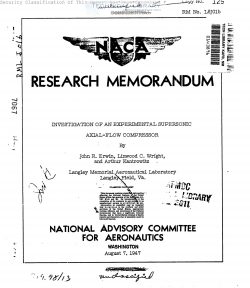naca-rm-l6j01b
- Version
- 45 Downloads
- 3.26 MB File Size
- 1 File Count
- April 24, 2017 Create Date
- April 24, 2017 Last Updated
National Advisory Committee for Aeronautics, Research Memorandum - Investigation of an Experimental Supersonic Axial-Flow Compressor

An investigation is in progress at the Langley Laboratory of
the NACA to explore the possibilities of axial—flow compressors
operating with supersonic velocities relative. to the blade rows.
The first phase of this investigation, a study of supersonic
diffusers, has been _reported in reference 1. The second phase,
an analysis of supersonic compressors, has been reported in
reference 2. Preliminary ca-lculations have shown that very high
pressure ratios across a stage, together with somewhat increased
mass flows, are possible vith compressors which _decelerate air
through the speed of sound in their rotor blading. These performance
characteristics are desirable in compressors for aircraft jet—
propulsion units, gas turbines, or superchargers. The third phase,
presented herein, is a preliminary experimental investigation
of a supersonic compressor -designed to produce a high press ure
ratio in a single stage.
It is commonly supposed that flow at speeds- higher than the
speed of sound necessarily involves large energy lbs-see. The
first two phases of this investigation, vehioh have been reported
in references 1 and 2, were primarily concerned with the magnitude
of these. losses. It has been demonstr_ated theoretically (reference 2)
that the waves which are primarily responsible. for the high drag of
isolated bodies at supersonic speeds Can-be entirely eliminated in
the case of a cascade. It is important that any normal Shock existing
be everywhere confined by the blading. Theoretibal results indicated
that, in cases where the normal shock is not confined, large losses
due to a wave system extending far from the cascade can result.
The other source of large losses -is that accom_91nying the confined.
Normal shock which decelerates air through the speed of sound. In order
to study the magnitude of these losses, the preliminary investigation
of supersonic diffusers was undertaken. It was found possible to
design supersonic diffusers to decelerate air from mach numbers up
to 2 through the_speed of sound with efficiencies comparable with
those obtained with good subsonic diffusers. .These two preliminary
investigations have indicated no cause for the efficiency of super—
sonic c0mpressors to be necessarily low. Because of these encouraging
results, teets- were made of an experimental supersonic cempressor at
the Langley Laboratory of the NACA.
| File | Action |
|---|---|
| naca-rm-l6j01b Investigation of an Experimental Supersonic Axial-Flow Compressor.pdf | Download |

Comment On This Post